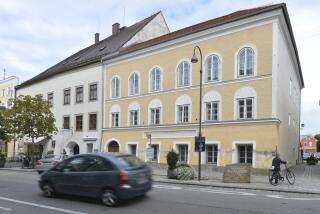On the Road to Berlin, a Few Potholes
BERLIN — If everything had gone according to plan, Chancellor Helmut Kohl would already be working out of a gleaming new federal chancellery here in Germany’s once and future capital.
But creating new seats of government can be a lengthy process, and as things have turned out, Kohl just turned the first shovelful of earth for the new chancellery this week.
The $240-million building, Germany’s equivalent of the White House, will take the form of a long, narrow bar running east to west, a shape and orientation meant to symbolize today’s connection between the formerly divided German states.
It isn’t just the chancellery construction that has fallen behind the optimistic schedule envisioned in 1991, when the Federal Assembly narrowly voted to move the government here. The process of moving from Bonn has proved so unwieldy that completion has been pushed back to 2000.
The government is still coming--but not readily. Seven of the 16 federal ministries will remain in Bonn after the move. And though the Federal Assembly is supposed to start holding plenary sessions in Berlin in April 1999, legislative work at the committee level will continue in Bonn into 2000.
The price tag for the move to Berlin is now expected to exceed $13 billion--a staggering burden at a time when Germany is paying to modernize the former East Germany and has a record number of unemployed.
Despite the setbacks, Kohl exuded his characteristic good cheer in Tuesday’s ground-breaking ceremony: “For me, this is a great day.”
Kohl said the historic Bonn-to-Berlin move was of a piece with another of his great visions, that of a Europe united in a single currency and trading bloc.
One reason it is taking so long for these dreams to be realized is the sheer physical scope of the work. Kohl wielded his shovel at the edge of a 2-mile scar that is billed as Europe’s biggest construction site: land flattened by bombs toward the end of World War II, then razed by the East German regime to make way for the Berlin Wall.
Over the course of rebuilding this wasteland, workers will have to move 12 million tons of earth, employ new construction techniques to tunnel under ground water, reposition historic buildings without damaging them, build a new train station, and create a city-within-a-city of deluxe official apartments, shops, kindergartens, and underground highway junctions.
But the scale of the project is not the only factor slowing down the move. So is foot-dragging by the people slated to inhabit these attractive new premises.
Most German civil servants are comfortable with the leafy, village-like atmosphere of Bonn, and they have fought the move to Berlin with everything from protests to lawsuits.
In hopes of getting them to stop grumbling and start packing, the Federal Assembly agreed last July to a generous package of sweeteners. These include below-market-rate loans to buy new houses; free weekly flights back to Bonn for three years; “separation money” for families who must live apart during the move; new stoves; and other payments.
The freebies are helping: The demonstrations in Bonn have largely stopped. But the largess is causing resentment among the local population--particularly former Easterners, who had the idea that when they dumped their old Communist leadership, they were ridding themselves of officials who got unfair perks and privileges.
More to Read
Sign up for Essential California
The most important California stories and recommendations in your inbox every morning.
You may occasionally receive promotional content from the Los Angeles Times.










